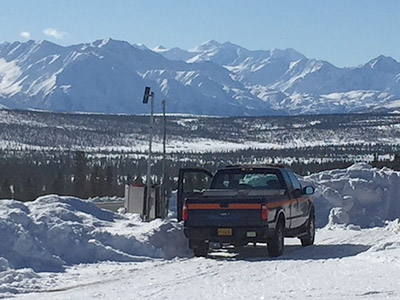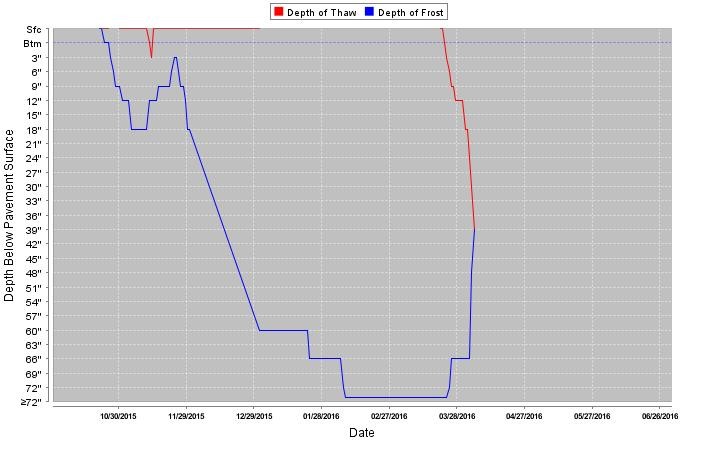Temperature Data Probes
Information Links:
Road Weather Information SystemRWIS Probe Data & Graphics
RWIS Probe Locations Map
RWIS TDP Information
Commercial Vehicle Weight Restrictions
10-Year History
Alaska DOT&PF Strategic Investment Section manages a system of Temperature Data Probes (TDP) in all regions of Alaska along remote highways and on major roadways in urban areas.
TDPs are 6 foot long probes installed vertically under the pavement in the shoulder of the roadway with 15 thermistors that take soil temperature readings. Temperatures are recorded just under the pavement, every 3 inches for the first foot, and then every 6 inches for the next five feet in depth. TDPs are co-located with existing CCS and at road weather information system (RWIS) stations.
Why are Temperature Data Probes important for the State of Alaska?

Temperature Data Probe station “Parks Highway @ Broadview”, Parks Highway, MP 40. Matt Murphy, Alaska DOT&PF
A primary purpose for temperature data underneath the roadbed is for setting and lifting weight restrictions; which, becomes necessary in the spring and fall when the ground is thawing and freezing. During these times, a layer of water collects between the pavement and the frozen ground beneath it causing the roadbed to become less stable leaving it susceptible to damage.
ADOT&PF Maintenance & Operations and Commercial Vehicle Enforcement use TDP data to help them make decisions for timely weight restrictions. In the past, M&O managers relied on local equipment operators throughout the state to go inspect roadways, culverts, and ditches to monitor conditions for determining when the ground was stable enough for lifting/implementing weight restrictions which can greatly impact commercial trucking companies and private vehicles.

Temperature Data Probe station “Eureka”, Glenn Highway, MP 128. Matt Murphy, Alaska DOT&PF
The TDP Program allows DOT&PF to monitor conditions over a large geographical area in near real time with daily automatic updates. This information in conjunction with other local observations adds a tremendous amount of precision in the timing with setting and lifting weight restrictions. Accurate timing reduces damage and costly repairs to roadways and increases efficiency for commercial trucking operations and other highway users.
Other purposes of the TDP Program include maintaining a research grade data set for monitoring long term data from these TDP stations to track trends in freezing depths and thawing cycles for the purpose of improving road design. Additionally, research organizations like universities and other private contractors have used data from the DOT&PF TDPs for a variety of projects.


